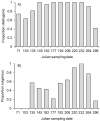Evidence for use of both capital and income breeding strategies in the mangrove tree crab, Aratus pisonii
- PMID: 34272445
- PMCID: PMC8285475
- DOI: 10.1038/s41598-021-94008-8
Evidence for use of both capital and income breeding strategies in the mangrove tree crab, Aratus pisonii
Abstract
Two common strategies organisms use to finance reproduction are capital breeding (using energy stored prior to reproduction) and income breeding (using energy gathered during the reproductive period). Understanding which of these two strategies a species uses can help in predicting its population dynamics and how it will respond to environmental change. Brachyuran crabs have historically been considered capital breeders as a group, but recent evidence has challenged this assumption. Here, we focus on the mangrove tree crab, Aratus pisonii, and examine its breeding strategy on the Atlantic Florida coast. We collected crabs during and after their breeding season (March-October) and dissected them to discern how energy was stored and utilized for reproduction. We found patterns of reproduction and energy storage that are consistent with both the use of stored energy (capital) and energy acquired (income) during the breeding season. We also found that energy acquisition and storage patterns that supported reproduction were influenced by unequal tidal patterns associated with the syzygy tide inequality cycle. Contrary to previous assumptions for crabs, we suggest that species of crab that produce multiple clutches of eggs during long breeding seasons (many tropical and subtropical species) may commonly use income breeding strategies.
© 2021. The Author(s).
Conflict of interest statement
The authors declare no competing interests.
Figures





References
-
- Mendo T, Semmens JM, Lyle JM, Tracey SR, Moltschaniwskyj N. Reproductive strategies and energy sources fueling reproductive growth in a protracted spawner. Mar. Biol. 2016;163:2. doi: 10.1007/s00227-015-2785-7. - DOI
-
- Bonnet X, Bradshaw D, Shine R. Capital versus income breeding: An ectothermic perspective. Oikos. 1998;83:333–342. doi: 10.2307/3546846. - DOI
-
- Johnson RA. Capital and income breeding and the evolution of colony founding strategies in ants. Insectes Soc. 2006;53:316–322. doi: 10.1007/s00040-006-0874-9. - DOI
MeSH terms
LinkOut - more resources
Full Text Sources

